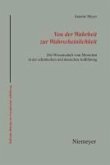The study is a contribution to the history of the theory of aesthetic thinking in the 18th century using the concept of emotion as its guide. Using an extended notion of aesthetics, texts are drawn upon from philosophical affect theory, from experiential psychology, anthropology and art theory from Descartes via German popular philosophy, and exemplary readings are used to show the basis for turning to the aesthetic subject, to feeling in the discourse of aesthetics in the late 18th century.
Dieser Download kann aus rechtlichen Gründen nur mit Rechnungsadresse in A, B, BG, CY, CZ, D, DK, EW, E, FIN, F, GR, HR, H, IRL, I, LT, L, LR, M, NL, PL, P, R, S, SLO, SK ausgeliefert werden.
"Ernst Stöckmanns Buch ist ein beachtlicher Beitrag, der auf dem Gebiet der Ästhetik Anregungen systematisiert, die aus dem wissenschaftlichen Interesse an der Anthropologie der Aufklärung herrühren. Er zeigt auf überzeugende Art und Weise, dass die Zeit zwischen Baumgarten und Kant weder unoriginell noch langweilig, sondern vielmehr erfüllt war von der hartnäckigen Suche danach, wie man die Starrheit der traditionellen rationalistischen Paradigmen überwinden könnte in dem Bemühen, die Emotionen zu erfassen und sie in der Folge in ästhetische Fragestellungen einzubeziehen. [...]Stöckmanns Buch macht deutlich, dass es in der deutschen spätaufklärerischen Ästhetik neben der Kantschen Theorie auch andere, in ihrer Zeit einflussreiche, wenn auch letzten Endes unterlegene Strömungen ästhetischen Denkens gab."
Tomás Hlobil in Estetika XLVIII (1) /2011
Tomás Hlobil in Estetika XLVIII (1) /2011









